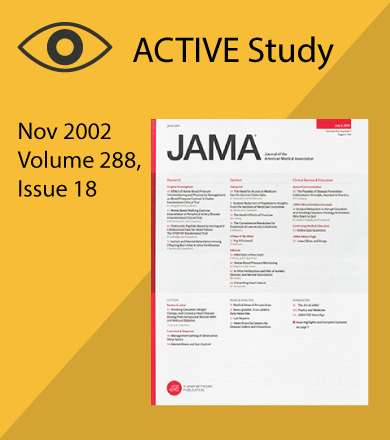A Large-Scale Study on Different Types of Cognitive Training
With 2,832 participants, the ACTIVE Study is the largest study on cognitive training with standardized outcome measures ever performed. Funded by the National Institutes of Health and led by researchers at six academic research universities (including Johns Hopkins, Penn State, and the University of Alabama at Birmingham), the ACTIVE study proves that healthy older adults can make significant cognitive improvements with appropriate cognitive training and practice. It also demonstrates that the training in BrainHQ drives improvements in more ways than other types of cognitive exercise.
Study Goals and Design
The ACTIVE study was designed to evaluate three different types of cognitive training: one that focused on memory, one that targeted reasoning, and BrainHQ training that exercised speed of processing. The study was conducted at six sites across the United States, and all of the participants were healthy adults aged 65 or older. Each cognitive training group was compared to a group of people who did not do specific cognitive training. The people in the cognitive training groups trained for 2 hours per week for 5 weeks (10 hours total), and then about half of them did additional “booster” training a year later and then again three years later. Researchers followed participants for ten years to evaluate the long-term effects of training.
The BrainHQ Training: Double Decision
The speed-of-processing training that ACTIVE study participants used was an earlier version of the BrainHQ exercise Double Decision (first called “speed training”, then called “Road Tour”). In Double Decision, the user has to spot a target in the middle of the screen while simultaneously noticing a target in the periphery—even when they flash on screen very briefly. Over time, the brain speeds up, and is able to process the targets more and more quickly.
To make sure Double Decision retained all the scientific accuracy of the original exercise used in the ACTIVE study, our science team worked hand-in-hand with the original developers of the exercise. Learn more about Double Decision.
Superior Results from Posit Science Training
All three types of cognitive training tested in the ACTIVE study resulted in cognitive improvements after the initial training period, but participants who used the BrainHQ exercise experienced the best results overall. According to the study, 87% of the participants who used BrainHQ’s Double Decision showed meaningful increases in the targeted cognitive ability, while 74% of participants who used reasoning training and 26% of those who used memory training showed improvements.
Importantly, the benefits of Double Decision training generalized beyond the targeted cognitive ability. People in the Double Decision group showed protection against declines in their abilities to live independently on their own (which was also seen in the other cognitive training groups). Uniquely to Double Decision, people showed protection against the risk of serious decline in health-related quality of life and the risk of the onset of depressive symptoms. Furthermore, people showed a significant improvement in driving safety: their risk of an at-fault car crash was nearly halved. Finally, people who trained the most (those in the booster groups) not only improved their speed of processing, but also showed improvements in everyday speed—such as reading an ingredient list or looking up a phone number—more easily and quickly.
Lasting Effects
At both 5-year and 10-year follow-ups, ACTIVE study participants who used the BrainHQ training continued to show significant cognitive improvements, even though they were not training continuously across that time. This shows that a person doesn’t need to continually do brain training to see and maintain benefits—a person can take breaks and then come back to brain training to sustain benefits.
Only in BrainHQ
The only computerized cognitive training exercise used in the ACTIVE study was Double Decision, now found in BrainHQ. This exercise is not available in any other cognitive training program.
In fact, one of the most interesting results from the ACTIVE study is that different cognitive training interventions work differently, and some work better than others. That means that every cognitive training program should go through a large scale trial like ACTIVE—developers cannot simply say “ACTIVE showed cognitive training works” because ACTIVE showed that a specific cognitive training program works. BrainHQ is the only commercially available brain training program that has been shown by the ACTIVE study results to improve cognitive function, sustain quality of life and functional independence, and deliver results that last over time.
Accessing Double Decision
You can use all the Double Decision content that the ACTIVE participants used on BrainHQ. If you’re already a BrainHQ subscriber, start now. Otherwise, you’ll have to subscribe to BrainHQ to access the exercise.
Further Reading
You can read a good overview of the ACTIVE study published by two of its lead scientists (without reading all of the dozens of primary papers) here. This review was published in 2013, so it covers much of the ACTIVE study results but not the most recent results. Remember, the term “speed training” in this paper refers to the training program now called “Double Decision” in BrainHQ.

